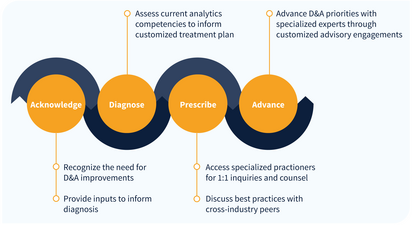Client Inquiry:
How can we effectively quantify and communicate the ROI of our analytics initiatives to secure continued investment and stakeholder support? This question is in the context of me leading a regional analytics team within a global enterprise, operating in a hybrid model that blends global direction with local delivery. While the team builds a range of data products across business domains, we struggle to assess and articulate whether those solutions deliver real, measurable value—especially for initiatives with indirect or strategic benefits.
Expert Takeaways:
1. Focus Where the Value Converts
Not all stakeholders can translate insight into impact—and that should influence how you manage your team’s time. When requests come in from across the business, it’s tempting to treat all reporting and analytics needs equally. But some leaders are far better than others at converting data into action. Over time, patterns emerge. Some groups use the tools and deliver results. Others don’t. That doesn’t mean their requests are invalid—but it does mean you should be thoughtful about where your team invests its limited capacity.
- Watch for slippage between insight delivery and business outcomes. Some functions or leaders absorb analytics better than others.
- Track which users or business units consistently turn analytics into measurable results, and prioritize their requests.
- When possible, design your analytics products so they can be tested. Embed them into line-level workflows where A/B testing is possible and measurable.
- Avoid overinvesting in purely executive reporting. It’s often hard to attribute business impact when the data doesn’t directly shape operational decisions.
2. Communicate Value with Evidence and Structure
Proving that analytics made the difference is hard. Communicating it is even harder. When executives receive a new tool or report, they often lack the context—or motivation—to connect the dots between the analytics product and the outcome. That’s why value capture must go beyond user acceptance testing. It requires embedded measurement, clear attribution, and shared definitions of benefit. One powerful approach is to classify benefits by both financial impact and strength of evidence. That structure not only makes communication easier—it makes investment defensible.
- Design controlled tests where possible, as mentioned in value conversion above. Even partial holdouts can provide a compelling signal of performance differences.
- Don’t rely on anecdotal feedback or indirect signs of success. Show actual impact using baseline comparisons or test/control groups.
- Use a value matrix to classify projects by type of benefit (financial vs. non-financial) and attribution strength (provable vs. speculative).
- Focus the portfolio on provable gains (e.g., direct cost reduction or revenue lift), but make room for strategic bets if core value is clearly demonstrated.
- Package and publish value stories like an internal annual report—with structure, polish, and clear financials—to signal credibility and drive support.
3. Unify Stakeholders Around Shared Value
When multiple analytics efforts operate in parallel—across functions, domains, or business units—tensions emerge. Stakeholders compete for attention, priorities fragment, and shadow analytics teams spin up their own solutions. To ensure that investments are visible, coordinated, and scalable, you must create a central backbone that supports innovation while maintaining coherence. That means building lightweight governance, common evaluation frameworks, and shared storytelling around impact.
- Formalize a data and analytics network that includes central teams and embedded squads. Use it to coordinate roadmaps and align on priorities.
- Create a clear handoff model: when an adjacent team prototypes something promising, central teams help productionize and scale it.
- Encourage shared presentation forums to surface in-flight projects, build awareness, and reduce duplicative efforts across groups.
- Use ROI narratives—like test/control results—to help prioritize which ideas get scaled, especially when funding is uneven across stakeholders.
- Clarify who is responsible for which layer of value: experimentation, enablement, industrialization, or maintenance. Then reinforce collaboration, not duplication.
Expert Network
IIA provides guided access to our network of over 150 analytics thought leaders, practitioners, executives, data scientists, data engineers with curated, facilitated 1-on-1 interactions.
- Tailored support to address YOUR specific initiatives, projects and problems
- High-touch onboarding to curate 1-on-1 access to most relevant experts
- On-demand inquiry support
- Plan validation and ongoing guidance to advance analytics priority outcomes
- Monthly roundtables facilitated by IIA experts on the latest analytics trends and developments
